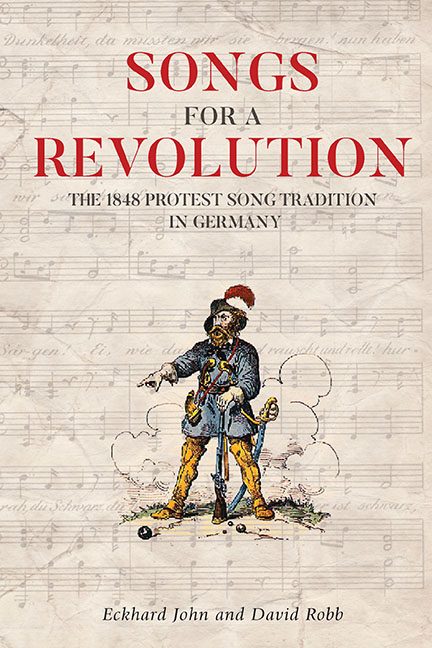Book contents
- Frontmatter
- Contents
- Preface
- Introduction: The Emergence of Political Song 1830–48
- Part I Before 1848: The Vormärz
- Part II 1848–49
- Part III 1848 in Memory
- Conclusion: The Making of Tradition; The Protest Songs of 1848 in the German Folk Revival 303
- Bibliography
- Discography
- Index of Names and Terms
- Index of Song Titles
9 - “In Kümmernis Und Dunkelheit” (“Schwarz-Rot-Gold”)
Published online by Cambridge University Press: 23 October 2020
- Frontmatter
- Contents
- Preface
- Introduction: The Emergence of Political Song 1830–48
- Part I Before 1848: The Vormärz
- Part II 1848–49
- Part III 1848 in Memory
- Conclusion: The Making of Tradition; The Protest Songs of 1848 in the German Folk Revival 303
- Bibliography
- Discography
- Index of Names and Terms
- Index of Song Titles
Summary
“IN KÜMMERNIS UND DUNKELHEIT” (“Schwarz-Rot-Gold”) was one of the first political songs to comment on the early revolutionary developments of the year 1848. In the text Ferdinand Freiligrath presented the colors black, red, and gold as symbols of the movement for democratic political change. The text was set to music in 1848 by various composers, including Robert Schumann, whose melody is the one that is used today. After falling into relative obscurity the song experienced a significant revival in the social democratic movement of the Weimar Republic, where the colors black, red, and gold acquired a renewed political relevance. In the post-1945 period “Schwarz-Rot-Gold,” as a song of the 1848 Revolution, was perceived as part of Germany's democratic cultural heritage in both the Federal Republic and the GDR.
Ferdinand Freiligrath wrote the poem “Schwarz-Rot-Gold” in mid- March 1848 in London, where he was living and working at the time. The text represented Freiligrath's critical response to the Frankfurt Bundestag's resolution of March 9, which had declared black, red, and gold to be the official colors of the German Confederation. This, as he saw it, was a blatant attempt by the powers-that-be to stem the rising tide of opposition by appropriating its symbols. In his poem Freiligrath counteracted this by giving the colors an explicitly more subversive interpretation. Inspired by the February 1848 Revolution in France, which he had already paid tribute to in his poem “Die Republik,” Freiligrath now raised his own lyrical German tricolor and pleaded for the rule of the princes to be abolished. The text first appeared on March 24, 1848 in the Deutsche Londoner Zeitung and thereafter in various prints that circulated as broadsides in Germany during the year of revolution.
While the poem functions, on one hand, as a commentary on the political developments of March 1848, it goes beyond that in additionally providing a new revolutionary interpretation of the colors black, red, and gold. The phrase “das alte Reichspanier” (the banner of the old empire) is a reference to the alleged origins of the colors in the medieval Holy Roman Empire. However, since the German Campaign (1812–14) during the Napoleonic Wars, the colors had begun to play an increasingly political role.
- Type
- Chapter
- Information
- Songs for a RevolutionThe 1848 Protest Song Tradition in Germany, pp. 131 - 146Publisher: Boydell & BrewerPrint publication year: 2020

